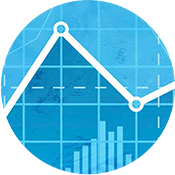As expected, the Trump administration announced ‘reciprocal’ tariffs on April 2nd. These tariffs ended up being more broad and larger than many anticipated, creating disruptions to the global economy and significantly raising the cost of living for U.S. consumers.
With the ‘reciprocal’ tariff announcement dominating the news cycle, economic uncertainty persisting, and the rapidly-changing nature of this administration’s policy making, we have decided to release our economic update today to share relevant information earlier and clarify some of the potential impacts of these developments.
If there was one important take-away from this newsletter, it would be to remember the value of staying invested, even in times of short-term volatility. Negativity in the news cycle and market noise can apply emotional pressure – making navigating these times of uncertainty more difficult. That said, the evidence shows that those who stay disciplined and invested generally outperform those who try to time the market.
In this week's economic update, we are discussing the impacts of ‘Liberation Day’ and the sweeping tariffs levied internationally this week. We unpack these recent developments, what this can mean for the economic outlook, and how the markets have responded to these tariffs. We are also sharing a couple more articles below to provide additional context and information.
In their most recent publication, RBC Economics’ Nathan Janzen and Claire Fan discuss how the latest round of U.S. tariffs spare Canada and Mexico, but how trade risks remain – particularly how trade uncertainty can threaten consumer and business spending.
We are also sharing the latest episode of The 10-Minute Take, which is exploring the role of Canadian services trade and it’s role within our country’s broader diversification efforts.
Economic Update
Global equity markets fell more sharply this week following the revelation from the U.S. administration that its reciprocal tariffs will be much broader and larger than most investors expected. The “Liberation Day” announcement raised the spectre of a more global trade war between the U.S. and many, if not all, of its trading partners. Below, we summarize recent trade developments, its implications on the economic outlook, and the response across equity, fixed income, and currency markets.
Canada and Mexico spared from new tariffs – for now
Tariffs have now gone global. In the past few days, the U.S. unveiled a 10% baseline tariff on all imports, plus much higher individual duties to be applied on close to sixty countries. The average U.S. tariff rate is now estimated to be just above 23%, up significantly from the 2% level from the beginning of the year. In a somewhat positive surprise, Canada and Mexico were spared, as neither country will face additional levies (although based on tariffs already in place, Canada still faces an average U.S. tariff rate on imports from Canada of approximately 3.5%). This removes, for now, some of the worst-case scenarios that investors were anticipating for both countries. As a reminder, Canada is already facing a 25% tariff on goods, including autos and parts made in Canada, not covered under the USMCA trade agreement signed in 2018, a reduced 10% duty on energy and potash not covered under USMCA, and a 25% tariff on steel and aluminium. Escaping the worst of the tariffs is positive for Canada on a relative basis and helps to reduce the growing incentive for U.S. importers to look elsewhere. However, that will be little consolation if overall tariffs are large enough to shrink U.S. demand and the total U.S. import market overall.
U.S. stocks most impacted, Canada fairing slightly better
The market reaction to the tariff developments was predictable in some cases, and surprising in others. The U.S. stock market bore the brunt of the weakness, continuing a trend that’s been in place this year. Technology and industrial sectors were particularly weak as investors are increasingly questioning the resilience of the U.S. economy and the growth expectations embedded in its stock market. The Canadian market fared a bit better, with bank stocks demonstrating some resilience, helping to offset some of the weakness from the energy sector. Overseas equity markets were also lower, albeit to a lesser degree.
Currency impacts may be indicative of reassessment of the U.S.
Not surprisingly, government bond yields moved lower (and prices higher) as investors have grown concerned about global growth and have sought safe-haven assets. The move in U.S. bond yields was noticeably more pronounced than in Canada. The bigger surprise may have been in the currency markets with the Canadian dollar, Euro, and Japanese Yen, among others, rising meaningfully following the tariff announcement. Traditionally, the U.S. dollar has been the key beneficiary in a “flight to safety” environment marked by equity market selloffs. But, that has not been the case recently, and may be indicative of investors reassessing the U.S. from multiple perspectives.
Summary
The high level of uncertainty in recent months caused by the threat of tariffs may have already resulted in some economic impact in the form of slower spending, investment, and activity. But the tariff announcement over the past week represents a new possible shock to the global economy that could result in higher prices across a range of products, lower spending, and shifting supply chains as businesses and consumers look for substitutes where possible. And while a recession is by no means a foregone conclusion, the risk of one occurring has risen. Central banks like the U.S. Federal Reserve are unlikely to stand pat should economic trends deteriorate but lowering rates in the face of rising prices may be somewhat uncomfortable for them. It is a possibility that these developments are a mechanism for the Trump administration to bring the impacted nations to the negotiating table – and we do expect this to begin happening.
Looking at the impact these ‘reciprocal’ tariffs are having on the equity markets as a whole the last couple days, it is important to remember future-looking nature of the markets. The risk of tariffs becoming longer term is contributing to market weakness, and we do expect that markets will begin to refocus on 2026 and the potential for policy changes that will support growth. We should continue to expect volatility, while also remaining discipled in our approach to investing. History has demonstrated that medium-sized corrections can recover within four months of the ‘trough’ – it reinforces the value of remaining disciplined, investing in good companies, and maintaining a long-term view.
U.S. reciprocal tariffs spare Canada/Mexico for now but trade risks remain

The exemption of Canada from the latest barrage of U.S. trade tariffs (for now, through CUSMA/USMCA complaint trade) is a relative positive. Tariffs remain a factor, with the average U.S. tariff rate on imports from Canada at about 3.5%, but this appears small when you contrast this with the higher tariffs felt internationally.
In this article from RBC Economics, you can learn more about the potential impacts of the tariffs on Canada and internationally, including the downside risks for the U.S. by clicking here.
Case study: Keeping focus on the long-term by staying invested

We’ve seen a lot of back and forth as to where tariffs will land, generating a lot of uncertainty and some volatility. At times like these, it is nearly impossible for investors to predict the future. Trying to time the good days in the markets is just as difficult as trying to time the bad days – what becomes critical is the ability to remain focused on the long-term by staying invested.
You can learn more detail about the above case study, illustrating the value of investor discipline and staying in the market, by clicking here.
The 10-Minute Take: Are services immune to tariffs in the trade war?

The unfolding tariff situation has brought more attention to the need for the Canadian economy to diversify its trade – given our proximity and interconnected nature to the U.S., that is difficult to achieve with goods. However, does that same constraint apply to services?
In this latest episode of The 10-Minute Take, economists Claire Fan and Carrie Freestone unpack Canada’s services trade, our key service trading partners, Canada’s ability to leverage services to broaden trade diversification, and what headwinds could exist.
You can listen to the episode by clicking here.
As always, we are available to connect with you personally. Please don’t hesitate to contact us at 519-822-2024 or elineskyschuett@rbc.com.
